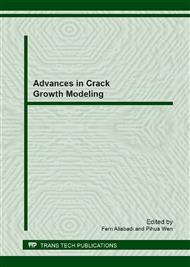[1]
Bittencourt T.N., Wawrzynek P.A., Ingraffea A.R., Sousa J.L. Quasi-Automatic Simulation of Crack Propagation for 2D LEFM Problems. Engineering Fracture Mechanics, 55, 321–334, 1996.
DOI: 10.1016/0013-7944(95)00247-2
Google Scholar
[2]
Ingraffea A.R., Wawrzynek P.A. Finite Element Methods for Linear Elastic Fracture Mechanics, Comprehensive Structural Integrity, Chapter 3.01, 1-88, 2007.
DOI: 10.1016/b0-08-043749-4/03007-x
Google Scholar
[3]
Belytschko T., Krongauz Y., Organ D., Fleming M., Krysl P. Meshless methods: an overview and recent developments. Comput. Methods Appl. Mech. Eng. 139, 3-47, 1996.
DOI: 10.1016/s0045-7825(96)01078-x
Google Scholar
[4]
Moes N., Dolbow J., Belytschko T. A finite element method for crack growth without remeshing. Int. J. Numer. Methods Eng. 46, 131-150, 1999.
DOI: 10.1002/(sici)1097-0207(19990910)46:1<131::aid-nme726>3.0.co;2-j
Google Scholar
[5]
Belytschko T., Black T. Elastic crack growth in finite elements with minimal remeshing. Int. J. Numer. Methods Eng. 45, 601-620, 1999.
DOI: 10.1002/(sici)1097-0207(19990620)45:5<601::aid-nme598>3.0.co;2-s
Google Scholar
[6]
Cisilino A.P., Aliabadi M.H. Three-dimensional boundary element analysis of fatigue crack growth in linear and non-linear fracture problems, Engineering Fracture Mechanics, 63, 713-733, 1999.
DOI: 10.1016/s0013-7944(99)00047-8
Google Scholar
[7]
Leonel E.D., Chateauneuf A., Venturini W.S., Bressolette P. Coupled reliability and boundary element model for probabilistic fatigue life assessment in mixed mode crack propagation, International Journal of Fatigue, 32, 1823-1834, 2010.
DOI: 10.1016/j.ijfatigue.2010.05.001
Google Scholar
[8]
Leonel E.D., Venturini W.S. Dual boundary element formulation applied to analysis of multi-fractured domains. Engineering Analysis with Boundary Elements, 34, 1092-1099, 2010.
DOI: 10.1016/j.enganabound.2010.06.014
Google Scholar
[9]
Leonel ED, Chateauneuf A, Venturini WS. Probabilistic crack growth analyses using a boundary element model: applications in linear elastic fracture and fatigue problems. Engineering Analysis with Boundary Elements, 36:944–959, 2012.
DOI: 10.1016/j.enganabound.2011.12.016
Google Scholar
[10]
Aliabadi M. H., Rooke D. P., Cartwright D. J. An improved boundary element formulation for calculating stress intensity factors - application to aerospace structures. Journal of Strain Analysis for Engineering Design, 22 (4), 203-207, (1987)
DOI: 10.1243/03093247v224203
Google Scholar
[11]
Venturini W. S., Brebbia C. A. Some applications of the boundary element method in geomechanics. Int. J. Num. An. Meth. Geom., 7 (4), 419-433, 1983.
DOI: 10.1002/nag.1610070405
Google Scholar
[12]
Cruse T. A. Boundary Element Analysis in Computational Fracture Mechanics, Kluwer Academic Publishers, Dordrecht, 1988.
Google Scholar
[13]
Yan X. Automated simulation of fatigue crack propagation for two-dimensional linear elastic fracture mechanics problems by boundary element method. Engineering Fracture Mechanics, 74, 2225-2246, 2007.
DOI: 10.1016/j.engfracmech.2006.10.020
Google Scholar
[14]
Portela A., Aliabadi M. H., Rooke D. P. Dual boundary element method: Efficient implementation for cracked problems. International Journal for Numerical Methods in Engineering, 33, 1269-1287, 1992.
DOI: 10.1002/nme.1620330611
Google Scholar
[15]
Yan X. A brief evaluation of approximation methods for microcrack shielding problems. ASME J Appl Mech. 73, 694–696, 2006.
DOI: 10.1115/1.2127957
Google Scholar
[16]
Kebir H., Roelandt J. M., Foulquier J. A new singular boundary element for crack problems. Application to bolted joints. Engineering Fracture Mechanics, 69, 497-510, 1999.
DOI: 10.1016/s0013-7944(99)00008-9
Google Scholar
[17]
Kebir H., Roelandt J. M., Chambon L. Dual boundary element method modelling of aircraft structural joints with multiple site damagem. Engineering Fracture Mechanics, 73, 418-434, 2006.
DOI: 10.1016/j.engfracmech.2005.08.006
Google Scholar
[18]
Yan X. Microdefect interacting with a finite main crack. J. Strain Analysis Engineering Design, 40, 421–430, 2005.
DOI: 10.1243/030932405x16089
Google Scholar
[19]
Leonel ED, Venturini WS, Chateauneuf A. A BEM model applied to failure analysis of multi-fractured structures. Engineering Failure Analysis 18:1538–1549, 2011.
DOI: 10.1016/j.engfailanal.2011.05.014
Google Scholar
[20]
Mi Y. Three-dimensional analysis of crack growth. Topics in Engineering. V.28, Comp. Mech. Publications, 1996.
Google Scholar
[21]
Bazant Z.P., Pijaudier-Cabot G., Measurement of characteristic length of non-local continuum. Journal of Engineering Mechanics, ASCE, 115 (4), 755-67, 1989.
DOI: 10.1061/(asce)0733-9399(1989)115:4(755)
Google Scholar


